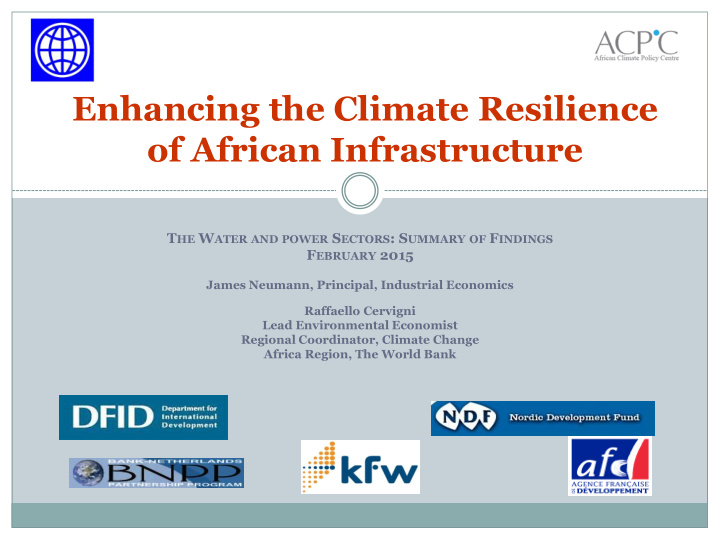



Enhancing the Climate Resilience of African Infrastructure T HE W ATER AND POWER S ECTORS : S UMMARY OF F INDINGS F EBRUARY 2015 James Neumann, Principal, Industrial Economics Raffaello Cervigni Lead Environmental Economist Regional Coordinator, Climate Change Africa Region, The World Bank
2
Vulnerability to Climate Change by Human Development Index 3
The issue: a long term commitment to infrastructure development.. PIDA long term targets Target by Sector 2040 Modern highways 37,300 km Hydroelectric power generation 54,150 MW Interconnecting power lines 16,500 km New water storage capacity 20,101 hm3 4
..in the context of a very different climate in the future.. Data refer to the Volta river basin Return to main slide show
..with increasing uncertainty on direction and magnitude of change 6
Objectives of regional report Overall: Strengthen the analytical base for investments in Africa ’ s infrastructure under a future uncertain climate; specifically: 1. Estimate the impacts of climate change on the performance of a subset of infrastructure over a range of climate scenarios 2. Develop and test a framework for the planning and design of infrastructure investment that can be “ robust ” over a wide range of climate outcomes; 3. Enhance the “ investment readiness ” of African countries to use climate finance to increase climate resilience of infrastructure
Summary of findings 8 1. Climate change has large effects on infrastructure performance; ignoring it may lead to significant “regrets” 2. Despite uncertainty, it is possible to plan infrastructure development so as to reduce regrets 3. There will be cost increases and cost savings; the benefits in terms of reduced risk outweigh the cost increase 4. Climate resilience is a new challenge, but is manageable
Scope of the water and energy analysis Seven River Basins Four Power Pools
Two tracks of analysis Track 1: coarser scale (basins and power pools) Emphasis on planning, trade-offs among policy objectives Track 2: specific investments scale Emphasis on project design options
The study team US/ Europe experts Africa experts Stockholm Environment Instit./ US Nile Basin Initiative (Uganda) • • Rand Corporation International Institute for Water • • and the Environment (Burkina Royal Institute of Technology – • Faso) Sweden Rhodes University (South Africa) • Massachusetts Institute of • Technology University of Cape Town (South • Africa) University of Massachusetts • Industrial Economics, Inc. •
The approach in 4 steps 12 A. Reference scenario : by 2030, what infrastructure, where, when, what performance (MW, Hectares, etc.) B. Impacts : how performance will be affected under 100+ climate scenarios (no adaptation) C. Perfect foresight adaptation : assume you knew in advance the climate, how would you modify plans ex- ante D. Robust adaptation : what are the planning choices that deliver performance in as many climate scenarios as possible
The reference scenario: a program of massive investment 13
Impacts 14
Large impacts on physical performance.. 15 Changes in physical performance of hydropower and irrigation under climate change (2015 to 2050) in the Congo, Orange and Zambezi basins Both sectors Irrigation over-performs-, over-perform hydropower under performs Both sectors Hydropower over- under-perform performs-, irrigation under performs
..and thus on economic performance.. 16 Change in present value of revenues from Hydropower and irrigation for SAPP Basins, Absent Adaptation Economic Impacts of Climate Change for SAPP Basins, Absent Adaptation
..across almost all basins 17 Changes in hydropower revenues from climate change (present value 2015 to 2050)
Large impacts on power consumers.. 18 Cumulative consumer expenditure on electricity (no climate change case=100%)
..and on agriculture imports 19 Cumulative expenditure on agriculture imports (no climate change case=100)
Adaptation 20
Six adaptation levers 21 Decision Variable Range of Lever Modification Basin Level Planned turbine capacity 50%, -25%, 0%, +25%, +50% Planned reservoir storage -50% or -25%. Mean conveyance Improved in increments of 10% from a baseline irrigation efficiency assumption of 75%, to 85% or 95%. Farm Level Planned irrigated area adjusted on a continuous basis from -50% to +50%. Mean deficit irrigation (of deficit irrigation of 30%, 20%, 10%, or 0%. water requirements) Mean field-level irrigation 60% in the Reference case, can be increased to efficiency 70% or 80% Annual crop imports (of Stop-gap measure total production)
In principle adaptation is attractive… 22 Gains from perfect foresight adaptation in hydropower
..but it can go wrong if not designed carefully 23 Damage from not adapting or mis-adapting hydropower expansion plans
Choosing a mini-max adaptation strategy.. 24 Zambezi basin: Regrets from alternative design options
..leads to large reduction in regrets.. 25 Reduced and residual regrets from the mini-max adaptation strategy
..with both cost increases and savings.. 26 Incremental cost of mini-max adaptation in hydropower
..making adaptation economically worthwhile 27 Benefit/ cost ratio of mini-max adaptation in hydropower (only considering cost increases)
What does it take to implement the approach? 28 1. A set of downscaled climate projections 2. A hydrologic model of the relevant region 3. A project design and cost model
Recommendations 29 Develop technical guidelines on the integration of 1. climate change in the planning and design of infrastructure in climate-sensitive sectors. Promote an open-data knowledge repository for 2. climate resilient infrastructure development Integrate climate resilience into project preparation 3. facilities Launch training programs for climate-resilient 4. infrastructure professionals Set up an observatory on climate resilient 5. infrastructure development in Africa, e.g with ICA
Next steps 30 March/April 2015: expert workshop to be convened with AUC April 2015: presentation/ launch, possibly at Africa Climate Resilient Infrastructure Summit (ACRIS) May/ June 2015: completion of the road transport component
Annex slides
Method can be used to capture different degrees of risk aversion 32
Modeling the interaction of climate, hydrology, energy and irrigation systems 33
Starting points: Africa Infrastructure Country Diagnostic (AICD)… Comprehensive overview of current infrastructure status, policy, institutional and financial challenges Concludes that Africa needs to spend US$93bn pa to catch-up on infrastructure with rest of developing world Estimates made under a “no climate change” presumption
Recommend
More recommend